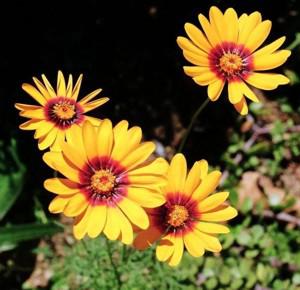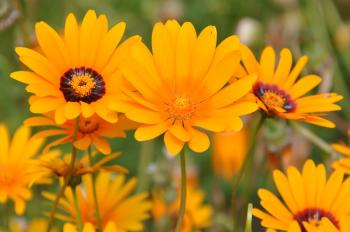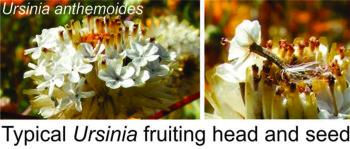Ursinia calenduliflora
Ursinia calenduliflora (DC.) N.E.Br.
Family: Asteraceae
Common names: Namaqua parachute daisy, Springbok rock-ursinia; bergmagriet, berggousblom (Afrikaans).
Introduction
This is a beautiful, spring-flowering annual, with large, orange-yellow daisy flowers, with dark rings around their centres and delicate lacy foliage.

Description
Description
Ursinia calenduliflora is an annual herb, up to 350 mm high, with finely dissected, fresh green, hairless leaves. The flower is a large, bright orange-yellow daisy, up to 50 mm in diameter, and a single flower is produced at the tip of a long, thin flower stalk. The ray florets are sterile and orange or occasionally yellow, with a purple spot at the base. The disc florets are hermaphrodite (contain male and female reproductive structures) and are yellow. There are two different flower forms, one with a dark ring of purple spots around the yellow centre and one with no dark ring.

Flowers are produced from mid- winter to spring, (July to September), depending on the weather; in a year with good and early rains, they will start flowering in July, and if the rain persists, they could continue flowering into late spring, however, in years with little rain, the flowers will be fewer and will be produced over a shorter period. The involucral bracts are free and occur in many, densely overlapping rows, and have conspicuous membranous tips.

Conservation Status
Status
Ursinia calenduliflora has been given a conservation status of Least Concern (LC), which means that it is not threatened.
Distribution and habitat
Distribution description
Ursinia calenduliflora occurs in sandy soil on rocky slopes in Namaqualand, the semi-desert region in the Northern Cape that is well known for its spectacular displays of spring flowers. It occurs from the Richtersveld Mountains to Springbok and the Kamiesberg Mountains.

Derivation of name and historical aspects
History
The genus Ursinia is named after Johann Heinrich Ursinus (1608–-1666), a theologian and botanist from Regensburg, Germany, who wrote Arboretum Biblicum. This species is named for its calendula-like flowers, Calendula being a genus of plants in the Asteraceae with large, showy daisy flowers from Europe and Asia, and commonly called marigold.
Ursinia is a genus of annuals, perennials and sub-shrubs of about 40 species, all native to southern Africa, with one species, that extends its distribution into North Africa. Most of them occur in the winter-rainfall area of the Northern Cape, Western Cape and Eastern Cape. Ursinias can be recognised by their large, showy daisy flowers; the thin, dry papery margins of their involucral bracts (which you one will see observe if you look underneath the flower); and their fruit (cypsela) that has a whorl of papery, petal-like bracts at the tip, which looks like a miniature flower and functions as a wing or parachute, and has earned ursinias the common name of parachute daisy. Ursinias are also known as bergmagriet or berggousblom, meaning mountain marigold, a name it shares with many other species with showy daisy flowers.
Other annual ursinias in cultivation at Kirstenbosch National Botanical Garden, include annual Ursinia anthemoides (common parachute daisy), U. cakilefolia (glossy-eye ursinia), U. speciosa (Namaqua ursinia) and perennial species U. abrotanifolia (lace-leaf ursinia), U. chrysanthemoides var. geyeri (coral ursinia) and U. sericea (silver lace-leaf ursinia).

Ecology
Ecology
Ursinia calenduliflora is an annual with a short lifespan, it germinates, grows, flowers, seeds and dies in a period of about six months. Annuals have evolved to survive in harsh environments where only part of the year has conditions suitable for growth or where they have to take advantage of short and/or variable periods of rain in an arid environment. Their strategy is to grow fast and set seed while they can and survive the inhospitable part of the year as dormant seeds. To take advantage of the short-lived resources, annuals have to be able to germinate fast, and grow and produce flowers fast and to produce a lot of seeds. This species is from a semi-arid, winter-rainfall area. It germinates with the first rains in autumn, grows during winter and flowers in late winter and spring. The seeds lie dormant during the hot, dry summer period until conditions become favourable for germination and growth return.
Members of the daisy family all have a pappus. This is the modified calyx or sepals, the part of the flower that surrounds the corolla, or petals. The pappus persists after pollination and is attached to the seed. The pappus can be bristly, or feathery, or scaly and usually enables some sort of dispersal of the seed. In Ursinia the pappus is a whorl of papery, petal-like bracts that looks like a tiny flower, and acts like a parachute and helps disperse the seed by carrying it in the wind. The seeds also have a tuft of silky hairs at the other end, which allows them to attach to a rough surface, such as sand.
The flowers attract many insects, such as flies, bees and beetles. The main pollinator is the Bee Fly, Megapalpus capensis. Ursinia calenduliflora has two kinds of flowers that often occur in the same geographical area. Flowers are either plain orange or they have pronounced dark red rings with dark spots at the base of the ray petals. The dark spots attract the Bee Flies that are searching for mates and are fooled by the dark spots thinking they are females. While searching for the non-existent mates, they pick up pollen and transfer it to other flowers, and this enables the plants to set more seed. However, the dark spots also attract certain flower-eating insects that damage the flowers, resulting in fewer seeds. Having both flower forms is a trade-off for this species.
Uses
Use
Ursinia calenduliflora is not used in traditional medicine, nor is it widely grown in gardens. It is easy and rewarding to grow and a colourful bedding plant for spring display.

Growing Ursinia calenduliflora
Grow
Grow Ursinia calenduliflora in full sun, in a light, well- drained (sandy) soil. They are best planted close together and en masse for maximum display of flowers, or in groups or clumps in a rockery or herbaceous border.
This species is propagated by seed. Treat it as a spring-flowering annual and sow seed in autumn (April–May). In colder climates where frost occurs, treat it as a summer annual and sow in spring after all danger of frost has passed. Seeds can be sown in situ where they are intended to grow, or they can be sown in trays or beds and transplanted into the garden when they are large enough to handle. Use a light, well-drained, weed-free medium, sow as evenly as possible on a windless day and cover the seeds lightly with the sowing medium or clean sand, or rake into the topmost layer of soil. Water gently using a fine spray and keep moist. Seeds germinate rapidly in 3–-7 days.
Prick out as soon as they are large enough to handle, and transplant into a sunny, north-facing bed, in well-drained, composted soil. Mix with other spring-flowering annuals, such as Ursinia cakilefolia (glossy-eye uUrsinia), U. speciosa (Namaqua ursinia) and U., anthemoides (common parachute daisy), Dimorphotheca sinuata (Namaqualand daisy), D. pluvialis (white Namaqualand daisy), Heliophila coronopifolia (blue flax), or Senecio elegans (wild cineraria).
References
- de Jager, M.L. & Ellis, A.G., 2014. Floral polymorphism and the fitness implications of attracting pollinating and florivorous insects. Annals of Botany. 113,(2): 213–-222.
- Jackson, W.P.U. 1990. Origins and meanings of names of South African plant genera. University of Cape Town.
- le Roux, A. & Schelpe, E.A.C.L.E. 1981. Namaqualand and Clanwilliam. South African Wild Flower Guide 1. Botanical Society of South Africa, Cape Town.
- Magee, A., Boatwright, J.S. & Mucina L. 2014. Four new species of Ursinia (Asteraceae, Anthemideae) from South Africa, with an updated key to the genus in Namaqualand. Phytotaxa 177, (3): 137–145.
- Pienaar, K. (2nd ed.) 2000. The South African What what flower is that edn 2. Struik, Cape Town.
- Snijman, D.A. (ed.). 2013. Plants of the Greater Cape Floristic Region 2: The Extra Cape Flora. Strelitzia 30. South African National Biodiversity Institute, Pretoria.
- Website: Catalogue of Life, http//blog.catalogueoflife.org/2013/09/taxon-of-day-ursinia-calenduliflora.html, accessed 9 December 2014
- Website: Plants of southern Africa online http://posa.sanbi.org, accessed 9 December 2014
Credits
Alice Notten and Nomama Mei
Kirstenbosch National Botanical Garden
January 2015
Plant Attributes:
Plant Type: Bi/Annual
SA Distribution: Northern Cape
Soil type: Sandy, Loam
Flowering season: Spring
PH: Acid, Neutral
Flower colour: Yellow, Orange
Aspect: Full Sun
Gardening skill: Easy
Special Features:
Horticultural zones










Rate this article
Article well written and informative
Rate this plant
Is this an interesting plant?
Login to add your Comment
Back to topNot registered yet? Click here to register.